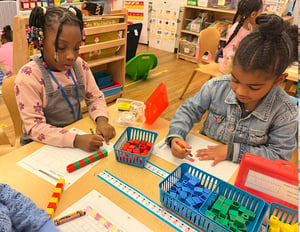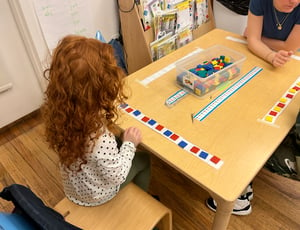Did you know that learning patterns in Kindergarten math develops critical thinking skills? Corlears Kindergarten teachers explain why patterns are crucial for future math learning and suggest fun games to practice at home.
At Corlears, students are encouraged to think like mathematicians. But what can that look like, exactly?
Students at Corlears are encouraged to develop fact fluency, or the ability to quickly recall math facts using existing understandings of numbers, and concepts like addition and subtraction, as opposed to rote memorization.
Our approach to teaching early math in Kindergarten is play-based and hands-on, empowering children to be flexible thinkers and develop a foundational number sense that serves them throughout their educational journey.
“Connecting math to everyday life is knowledge that students will gain throughout their Kindergarten math experience,” says Emily Billig, an elementary teacher at Corlears.
One of the ways our Kindergarten students begin to build those essential numeracy skills and learn to make predictions is through an exploration of patterns.
Why Teaching Patterns Is Important
“Teaching patterns helps kids grow into critical thinkers,” says Olympia Hamlor, the head Kindergarten teacher at Corlears.
By studying patterns, children begin to make informed predictions through observations. Children are able to see the relationships between different elements and can draw meaningful generalizations by spotting recurring patterns.


This ability to analyze information and group numbers develops a foundation for later math learning, like multiplication and division work, Olympia explains.
How We Teach Patterns
Our Kindergarten patterns unit explores patterns created through repeating basic units, such as AB, ABB, AAB, AABB, and ABC patterns. For example, a pattern of "red bear, blue bear, red bear, blue bear" follows an AB pattern, where "A" represents the first element and "B" represents the second element.

A key question students explore is, "What comes next?" This inquiry encourages students to consider the sequence-building process to determine the continuing pattern.
The exploration aims to deepen students' understanding of various pattern types through hands-on activities with materials like buttons, bears, dominoes, and beads of all different colors, shapes, and sizes to create patterns.
“In this way, students are able to use different materials to build patterns, finish other patterns, and connect patterns to their everyday life,” Emily says.
Pattern Games to Play at Home
Olympia suggests the following pattern games at home to practice this foundational mathematics skill with your child:
Patterns in the environment. Look for different patterns in your home and in your neighborhood. Ask your child to describe the pattern that they find.
Construct patterns together. Find items in your household or draw a pattern on paper. You and your child can take turns building, describing, and labeling the pattern.
Play the “What comes next?” game. Find items in your household to construct patterns, and take turns identifying what comes next.
Corlears School is a progressive independent school made just for young children located in the heart of Chelsea, teaching children ages 16 months through fifth grade. To learn more about our curriculum and academics, we encourage you to browse our program overview here.



